What is Enterprise SEO and How it Can Help You Outperform Your Competition
 All SEO is the same, right?
Well, not exactly. Large enterprises typically have complex websites that need careful consideration when it comes to Search Engine Optimization.
According to BrightEdge, 51% of all website traffic comes from organic search. So if you’re going to outpace the competition, you’ve got to do all you can to perform well in organic search. Your website, content and blog posts need to show up.
In this post, I’ll explain what enterprise companies and large businesses need to know about SEO, some strategies they can use to get started, and how to convince their top brass to adopt SEO.
Let’s begin.
All SEO is the same, right?
Well, not exactly. Large enterprises typically have complex websites that need careful consideration when it comes to Search Engine Optimization.
According to BrightEdge, 51% of all website traffic comes from organic search. So if you’re going to outpace the competition, you’ve got to do all you can to perform well in organic search. Your website, content and blog posts need to show up.
In this post, I’ll explain what enterprise companies and large businesses need to know about SEO, some strategies they can use to get started, and how to convince their top brass to adopt SEO.
Let’s begin.
SEO Templates to Help You Get Started
Wait a sec. Before we get started, check out this SEO content strategy template. It will help walk you through the process of planning all your keywords to crush your business and traffic goals.What is SEO?
Most Marketing Managers have a pretty good understanding of what search engine optimization (SEO) is. But let’s do a walkthrough for the sake of clarity. SEO is the process of optimizing your website and pages to get organic traffic from search engines like Google and Bing. Essentially, search engines work by collecting information from all over the Web and storing it in a database. Then, using an algorithm, they decide what pages they should show when a user types in a query. For example, if I search for “seo copywriting” in Google, this is what I see: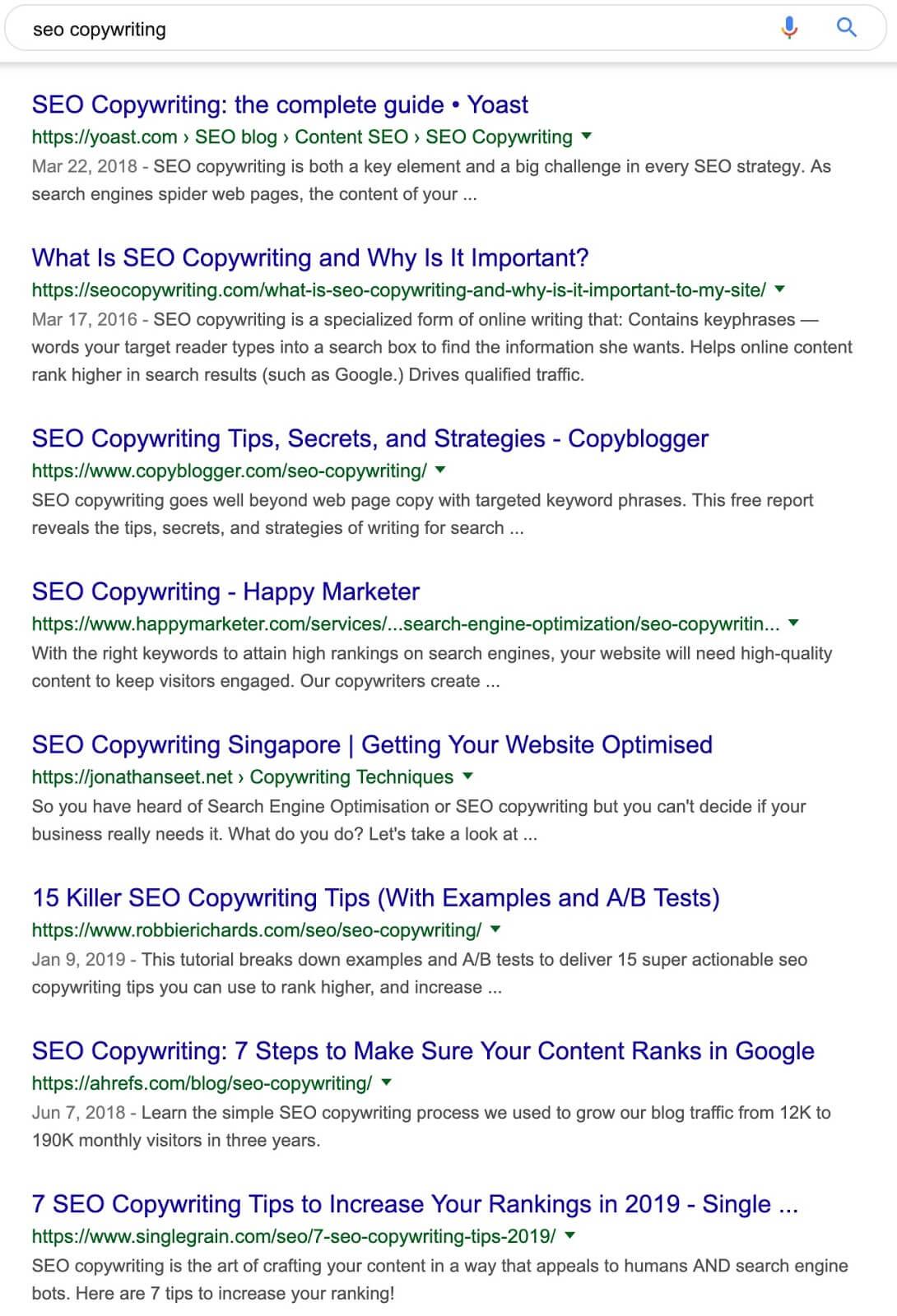 NOTE. You’ll likely see different results if you’re based in another location.
The goal of SEO is to ensure that your site is visible for relevant search queries so that you can get more traffic and sales.
NOTE. You’ll likely see different results if you’re based in another location.
The goal of SEO is to ensure that your site is visible for relevant search queries so that you can get more traffic and sales.
How Do Search Engines Work?
According to netmarketshare, 75% of all searches are done on Google. As a result, due to this sheer dominance, most SEOs are mostly interested in optimizing for Google. And Google is what we will focus on. Watch this video to learn how Google works:Crawling
Crawling is the process of finding pages on the web. To do this, Google uses a computer program known as a crawler (or spider) to discover pages and links. Google’s crawler is known as Googlebot. It kicks off this process by starting off at a known website. It then finds the links on the webpage and follows them to discover other pages. It then finds all the links on those pages and discovers even more pages. This process repeats infinitely and eventually, Google is able to discover (almost) everything on the web. A part of doing SEO is making it easy for Googlebot to discover your webpages.Indexing
Indexing is the process of extracting data from pages and storing in Google’s database. When Google crawls a site or its pages, attributes are recorded. Google looks at the elements of these pages, like the title, URL, links, etc. It then records all of these data and stores in a database. And this is how Googlebot “reads” the General Electric Appliance site: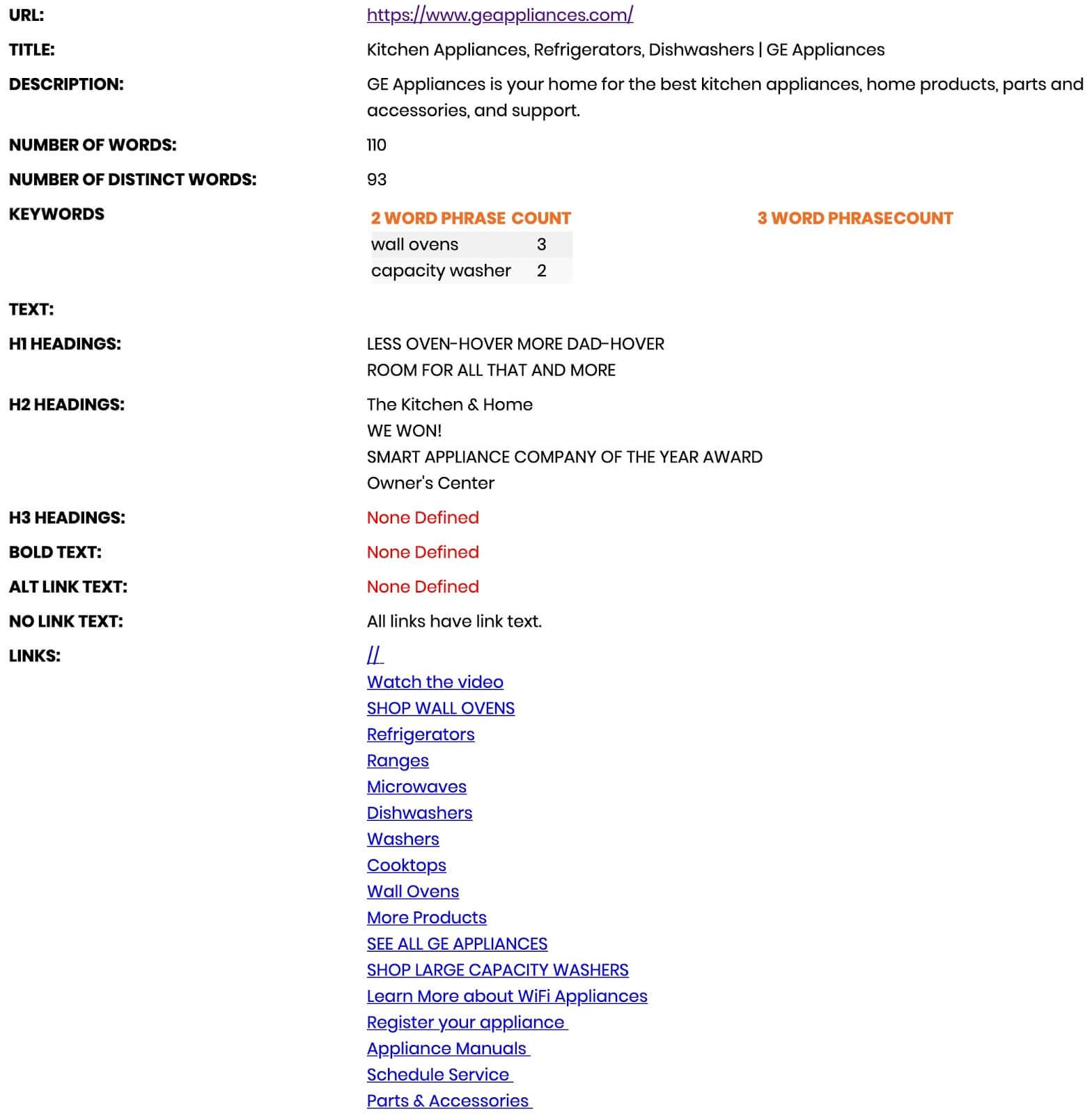 Doing SEO means ensuring what Google reads and indexes are as accurate as possible. This makes it more likely that our pages will show you for relevant keywords that we want.
Doing SEO means ensuring what Google reads and indexes are as accurate as possible. This makes it more likely that our pages will show you for relevant keywords that we want.
Delivering
When you enter a search query into Google, Google searches its database for relevant webpages and displays them as search results. How does Google know which pages are relevant? The answer: its algorithm. No one knows how the Google algorithm works, and Google clearly intends to keep this a secret. However, most SEOs do agree on one factor: the number of quality backlinks to a page. And a big part of SEO is figuring out how to get other sites to link to you.The Most Important Enterprise SEO Activities
It’s cool to learn how Google works, but one question still remains. How should big companies approach SEO? Here’s a roadmap to help your enterprise website perform better in search.Structure Your Website In A Way That Google Can Find
Remember how Google crawls the Web? It starts off with a known page, finds the links on it and then follows them to discover other pages. Google does the same thing with your website, too. It begins from one of your pages, finds internal links (links from pages on the same domain to another) and then discovers your other pages.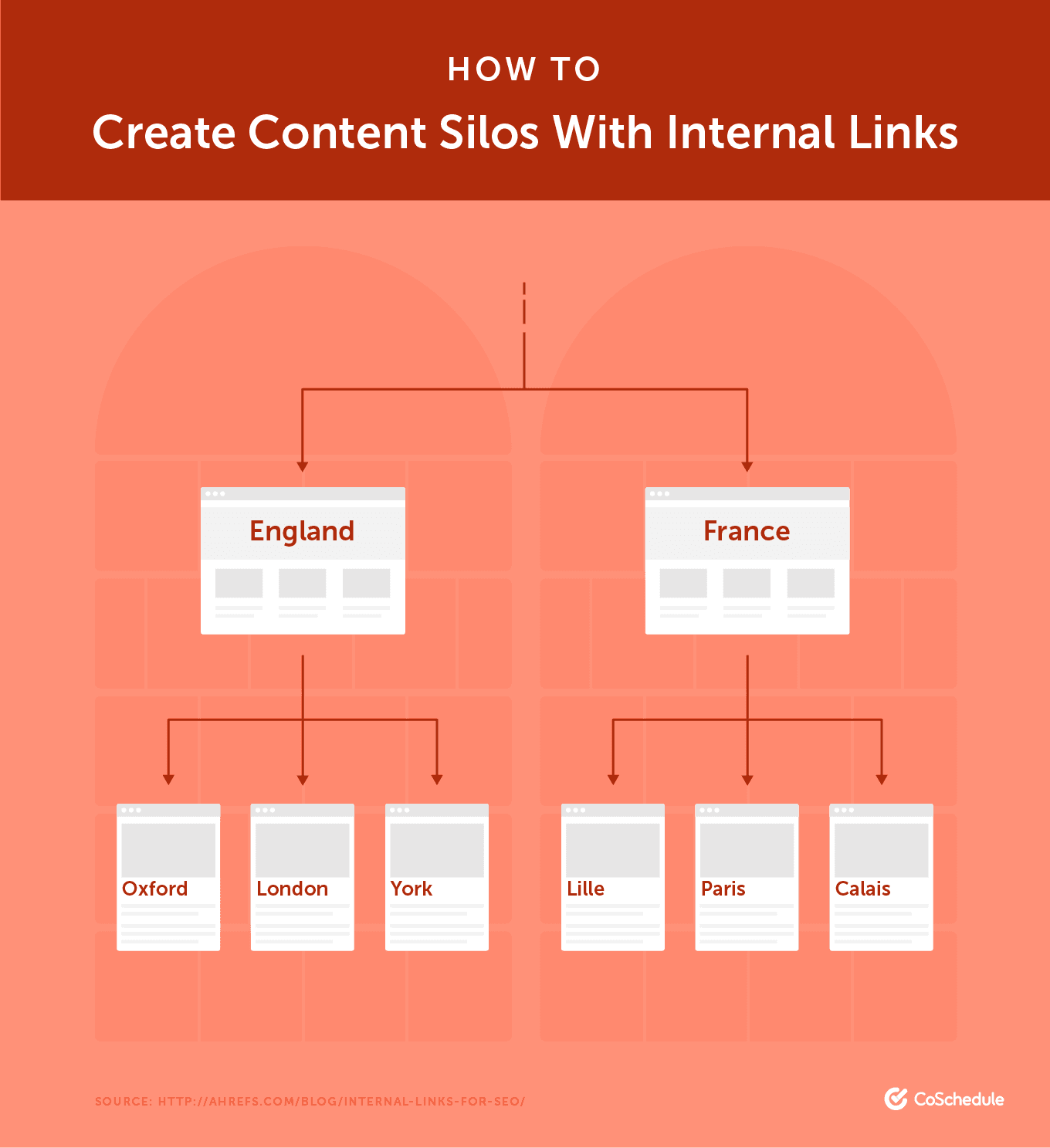 In this example, the main country page serves as the “hub.” It then links to subpages (“spokes”) about related cities (and vice versa.) This creates what SEOs call a “topic cluster” — a group of interlinked pages that are related to the same topic.
This hub-and-spoke model allows crawlers to easily understand your site structure. Plus, since the pages are all interlinked, link equity is “transferred” to your important pages.
This is a powerful concept that many companies have tested with phenomenal success. Buffer, G2, and HubSpot have attributed large gains in organic traffic due to re-organizing and building content hubs for their websites.
The process of creating a content hub is complex and can require a lot of moving parts. I’ll encourage you to read Ben’s guide on content hubs to help you get started.
In this example, the main country page serves as the “hub.” It then links to subpages (“spokes”) about related cities (and vice versa.) This creates what SEOs call a “topic cluster” — a group of interlinked pages that are related to the same topic.
This hub-and-spoke model allows crawlers to easily understand your site structure. Plus, since the pages are all interlinked, link equity is “transferred” to your important pages.
This is a powerful concept that many companies have tested with phenomenal success. Buffer, G2, and HubSpot have attributed large gains in organic traffic due to re-organizing and building content hubs for their websites.
The process of creating a content hub is complex and can require a lot of moving parts. I’ll encourage you to read Ben’s guide on content hubs to help you get started.
Be Strategic About Backlinks
In 2018, Ahrefs studied almost a billion pages to see how many of them actually get traffic from Google. It turns out: only 9.12% of all pages get search traffic. For the rest (90.88%), they are completely invisible.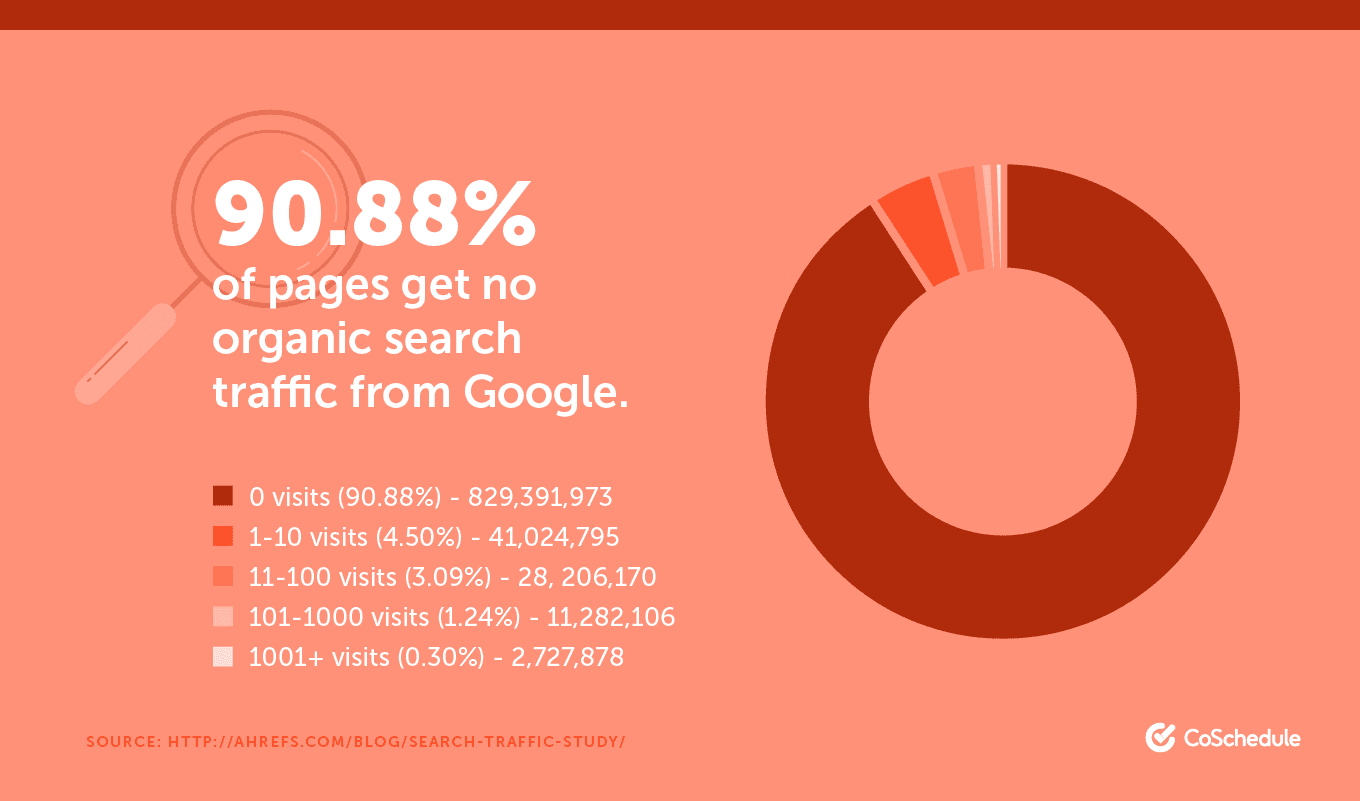 Why?
They don’t have any backlinks (55.24% of these pages don’t even have a single one).
Links are one of Google’s top 3 ranking factors. At Ahrefs, we’ve also found that backlinks are one of the factors that correlate well with search traffic.
Why?
They don’t have any backlinks (55.24% of these pages don’t even have a single one).
Links are one of Google’s top 3 ranking factors. At Ahrefs, we’ve also found that backlinks are one of the factors that correlate well with search traffic.
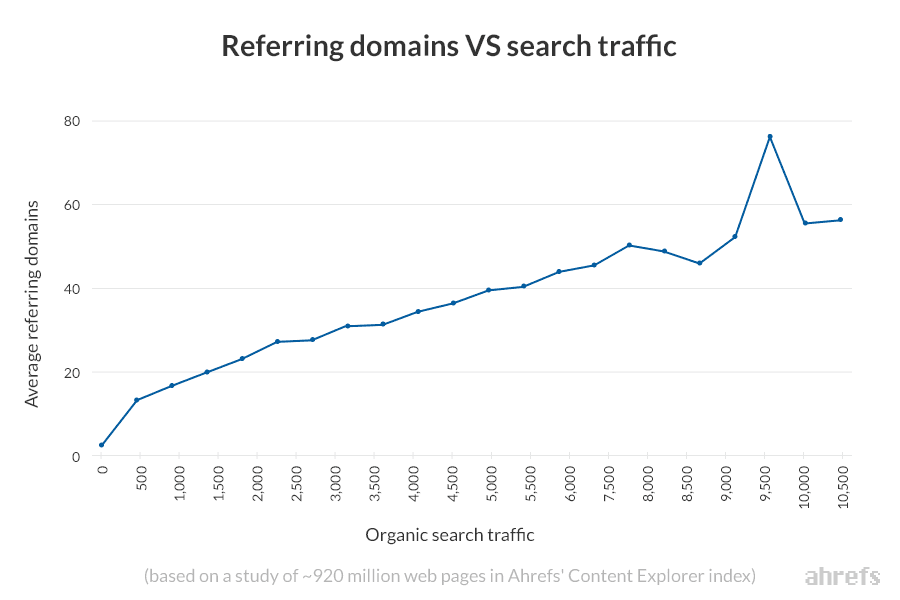 This explains why link building is such a big part of SEO.
This explains why link building is such a big part of SEO.
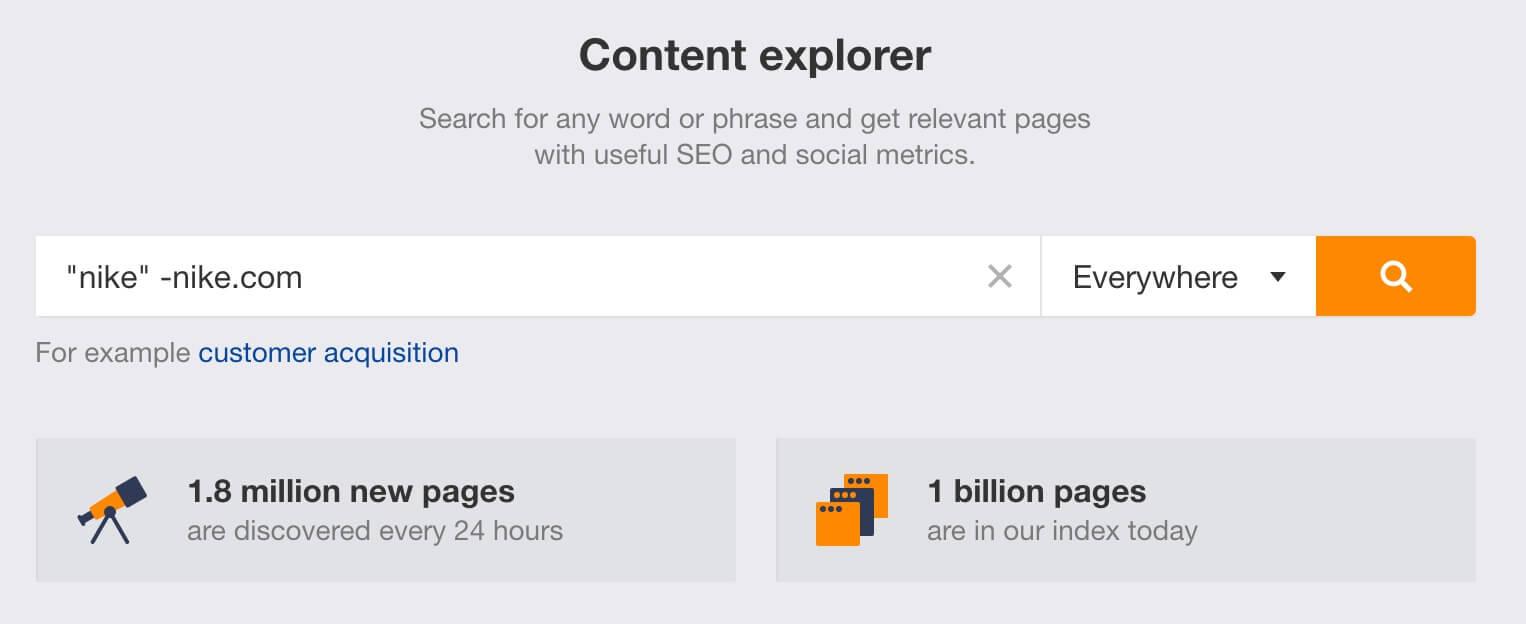 Add a few filters to narrow down the results (for e.g., English-only.) Then, use the “Highlight unlinked mentions” filter and add your own website.
Add a few filters to narrow down the results (for e.g., English-only.) Then, use the “Highlight unlinked mentions” filter and add your own website.
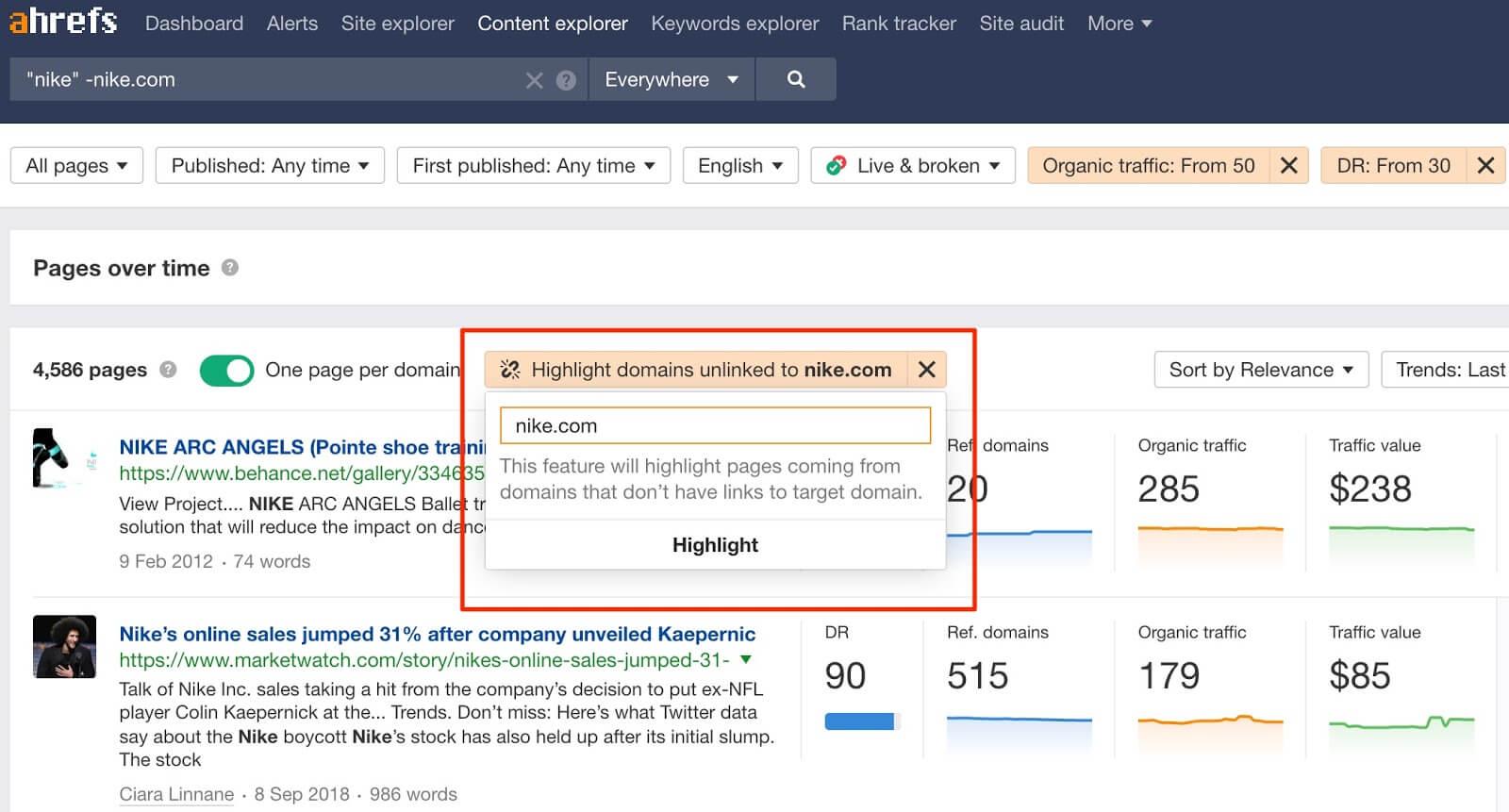 You now have a list of unlinked mentions.
The second strategy you can use is to send emails to people who have written about the same topic. This is known as outreach.
Since they’ve written about those topics before, there is a higher probability they’ll be interested in reading your article.
To find these people, simply enter the topic of your article into Google. Then, collect the list of articles that appear in the SERPs.
Find their email address (you can use hunter.io), and then send them a compelling email on why they should read or link to your post.
Some tips on making the email compelling:
You now have a list of unlinked mentions.
The second strategy you can use is to send emails to people who have written about the same topic. This is known as outreach.
Since they’ve written about those topics before, there is a higher probability they’ll be interested in reading your article.
To find these people, simply enter the topic of your article into Google. Then, collect the list of articles that appear in the SERPs.
Find their email address (you can use hunter.io), and then send them a compelling email on why they should read or link to your post.
Some tips on making the email compelling:
- Keep it short. Most people are busy. Go straight to the point and not beat around the bush.
- Tell them what’s in it for them. Everyone looks out for themselves. Add value and let them know what they can get out of it.
- Personalize the email. Most people hate templates. And if they think it’s one, they’ll delete it. Make it personal and genuine so that the receiver knows it’s a real email, and not one sent at scale.
Target Topics with Search Traffic Potential
In the same study of a billion pages, Ahrefs also discovered over 30,000 pages that don’t get any search traffic, despite having more than 200 referring domains.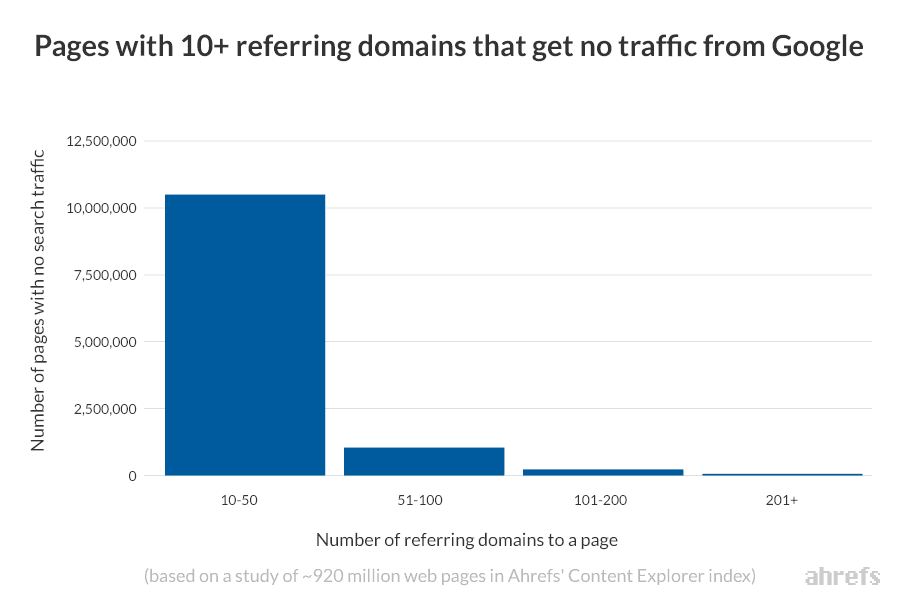 Why?
Because they didn’t target topics with search traffic potential.
If you want traffic from Google, you have to publish pages about topics people are searching for. To do that, you have to perform keyword research.
Keyword research involves finding the most popular words or phrases your customers use when searching for your business. This way, you can easily cater to and optimize your pages for those phrases.
There are many ways to do keyword research, but the fastest way to begin is to use a keyword research tool.
You can start off with using free keyword research tools, of which there are plenty. My personal favorite is AnswerThePublic.
Enter a keyword related to your business and AnswerThePublic will generate a bunch of ideas based on questions, prepositions, comparisons and so on.
Why?
Because they didn’t target topics with search traffic potential.
If you want traffic from Google, you have to publish pages about topics people are searching for. To do that, you have to perform keyword research.
Keyword research involves finding the most popular words or phrases your customers use when searching for your business. This way, you can easily cater to and optimize your pages for those phrases.
There are many ways to do keyword research, but the fastest way to begin is to use a keyword research tool.
You can start off with using free keyword research tools, of which there are plenty. My personal favorite is AnswerThePublic.
Enter a keyword related to your business and AnswerThePublic will generate a bunch of ideas based on questions, prepositions, comparisons and so on.
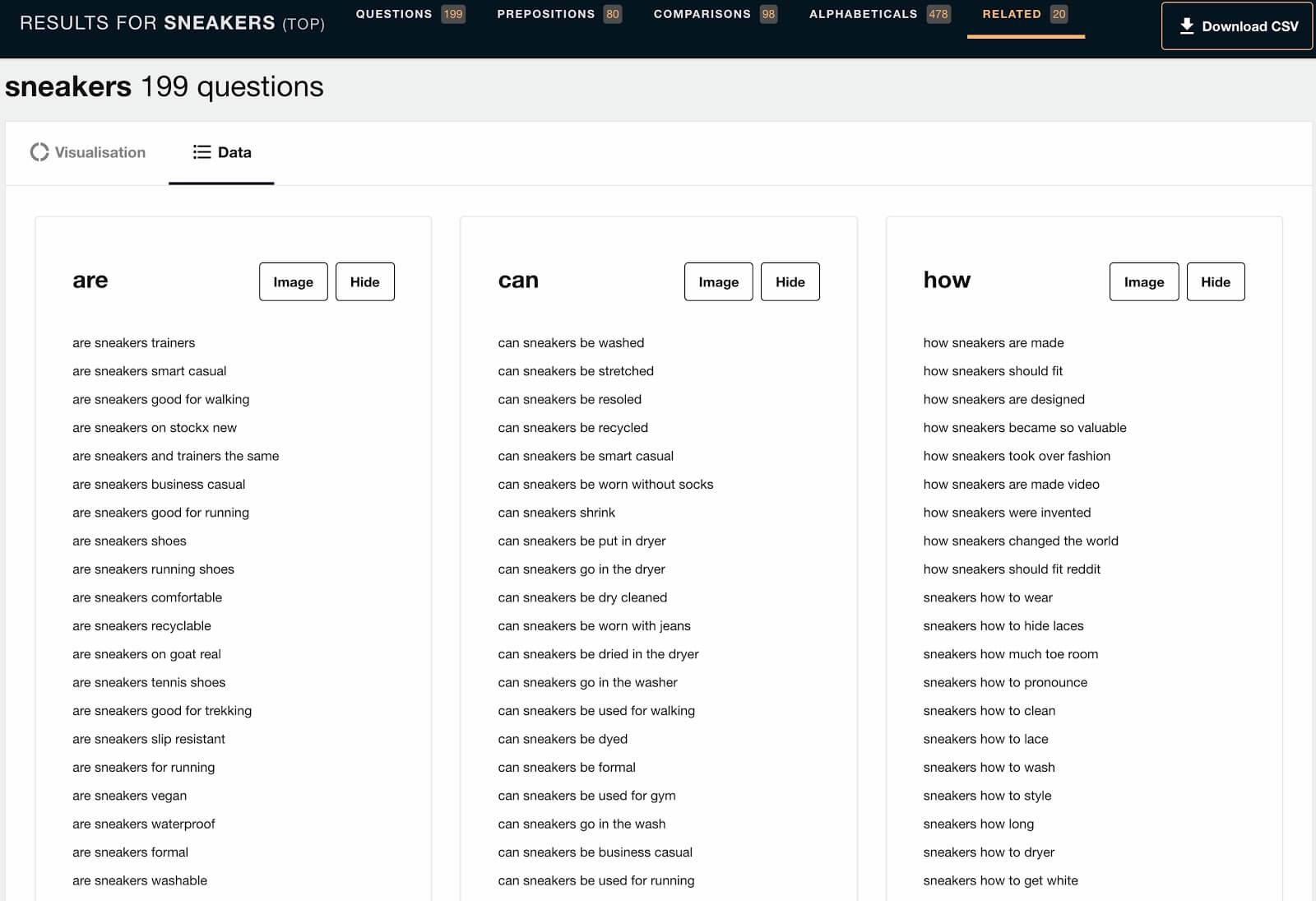 However, an issue with such tools is that they are often lacking in important keyword metrics that can help you decide if you should target them.
As such, it might be better to use professional keyword tools like Ahrefs’ Keywords Explorer, SEMRush or Moz. Not only can these premium tools show you important SEO metrics, they can also show you more keyword ideas.
However, an issue with such tools is that they are often lacking in important keyword metrics that can help you decide if you should target them.
As such, it might be better to use professional keyword tools like Ahrefs’ Keywords Explorer, SEMRush or Moz. Not only can these premium tools show you important SEO metrics, they can also show you more keyword ideas.
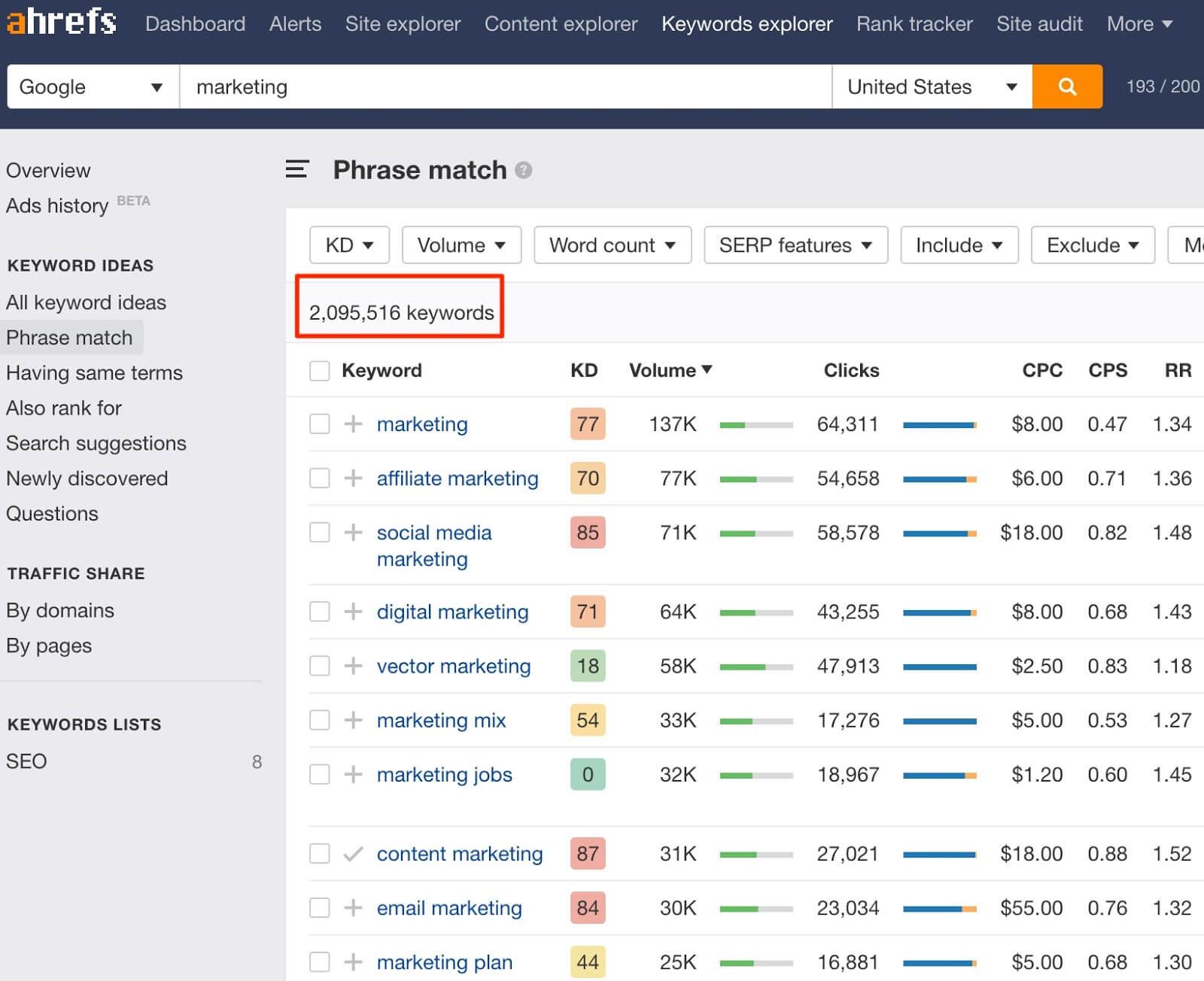 From there, review the generated keywords and add those that look promising to a spreadsheet of your choice. Look out for:
From there, review the generated keywords and add those that look promising to a spreadsheet of your choice. Look out for:
- Relevance - is this keyword or topic relevant to your business?
- Search volume - the monthly searches for that keyword. Generally speaking, the higher the search volume, the higher the search traffic potential.
- Keyword difficulty - how difficult it is to rank for that keyword. Some tools have a keyword difficulty/competition metric that tells you how competitive that keyword is. You can also do this yourself by reviewing the search engine results page (SERP). Learn more about how to do this here.
Create a Content Engine
In less than a year, G2 (formerly G2Crowd) grew their organic traffic to one million monthly search visitors. Not only did they perfectly execute the SEO strategies discussed above, they also understood that to reach their goal, they needed a content engine. Since January 2018, they have grown their team to 29 content marketers doing a variety of tasks - keyword research, link building, content creation, research, and so on. Great content doesn’t write itself. If you want constant organic traffic coming to your site, you’ll need a team. In general, there are two ways content marketing teams are structured:- Internal teams;
- External teams.
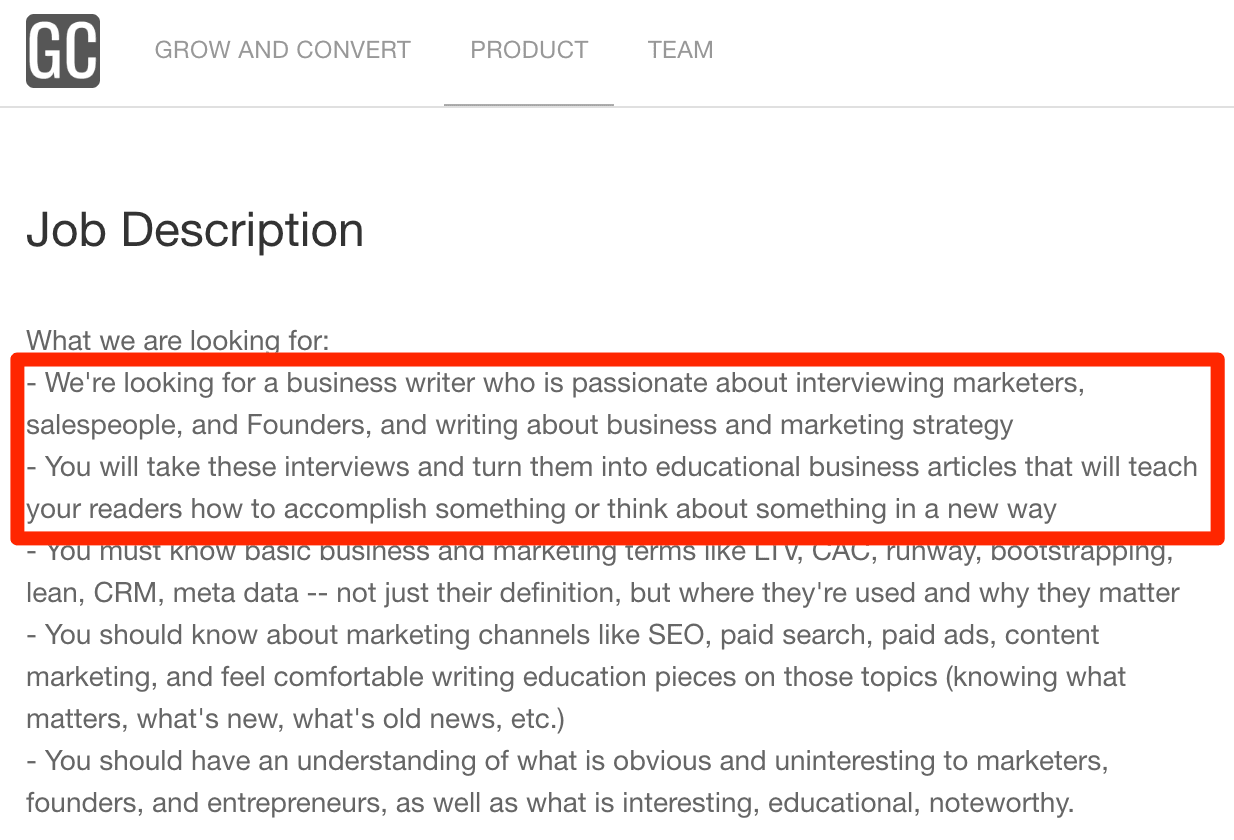 Once you have clarity, it’s time to search for them. An easy way is to post an ad on a job board.
I tested a number of job boards previously, and found that ProBlogger, BloggingPro and AngelList were the best places to post ads for freelance writers.
Alternatively, social media is a good choice.
Once you have clarity, it’s time to search for them. An easy way is to post an ad on a job board.
I tested a number of job boards previously, and found that ProBlogger, BloggingPro and AngelList were the best places to post ads for freelance writers.
Alternatively, social media is a good choice.
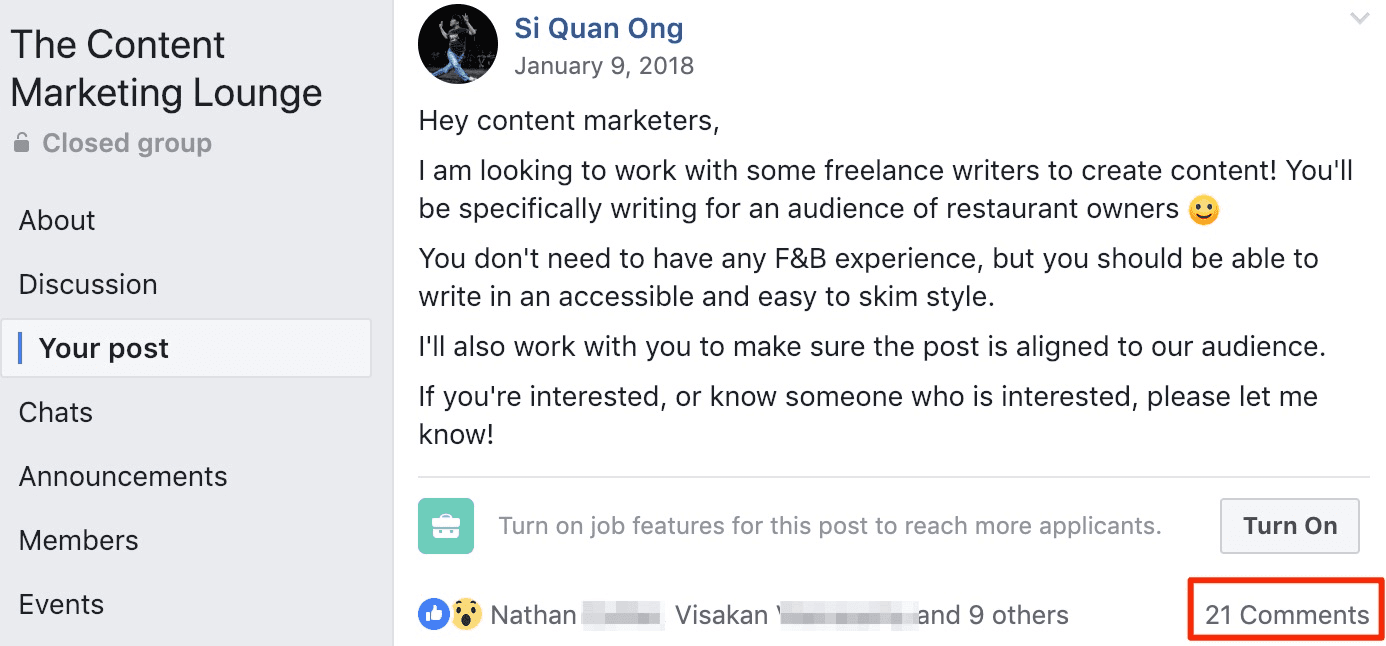 If you have the budget, find writers who contribute regularly to the top publications in your industry. Besides writing for these publications, they might also take up freelance writing as a side gig.
Now, hiring isn’t the only thing you need to get right.
Systems and processes are also required if you want to build a successful content engine.
It doesn’t matter whether you’re building an internal or external team — you’ll need checklists and playbooks to ensure your content marketers are consistently doing the right thing (and not missing out on any critical steps.)
Fortunately, CoSchedule has a whole bundle of content marketing checklists that you can plug into your content team and get started right away.
Remember though they’re not the end-all-be-all. As you begin executing, always make sure you tweak these checklists and adapt them to your unique situation.
If you have the budget, find writers who contribute regularly to the top publications in your industry. Besides writing for these publications, they might also take up freelance writing as a side gig.
Now, hiring isn’t the only thing you need to get right.
Systems and processes are also required if you want to build a successful content engine.
It doesn’t matter whether you’re building an internal or external team — you’ll need checklists and playbooks to ensure your content marketers are consistently doing the right thing (and not missing out on any critical steps.)
Fortunately, CoSchedule has a whole bundle of content marketing checklists that you can plug into your content team and get started right away.
Remember though they’re not the end-all-be-all. As you begin executing, always make sure you tweak these checklists and adapt them to your unique situation.
Approach SEO Like an Ongoing Marketing Project
SEO is not a set-it-and-forget-it task. There are less than ten spots on the first page of Google. Even if you’re ranking #1 today, your competitors will be nibbling at your heels. They want the #1 spot too, and they’ll do anything to try and get it. Therefore, you have to approach SEO as an on-going marketing project. Experimentation and iteration is the name of the game. You have to constantly measure and monitor your results and adapt your strategy accordingly. For that, I’d recommend you use a rank tracking tool (here’s a nice list) that keeps an eye on the keywords you’re targeting automatically. At Ahrefs, we monitor the main keywords we’re targeting for our pages: Once we see that our rankings and traffic for a specific page starts dropping, we’ll begin analyzing the reasons why.
Usually, it’s because some part of the page has become outdated.
When that happens, we’ll update that particular piece of content. Sometimes, we may even rewrite the entire article, depending on how much the search results in Google has changed!
Here’s what happened when we rewrote, republished and repromoted one of our articles:
Once we see that our rankings and traffic for a specific page starts dropping, we’ll begin analyzing the reasons why.
Usually, it’s because some part of the page has become outdated.
When that happens, we’ll update that particular piece of content. Sometimes, we may even rewrite the entire article, depending on how much the search results in Google has changed!
Here’s what happened when we rewrote, republished and repromoted one of our articles:
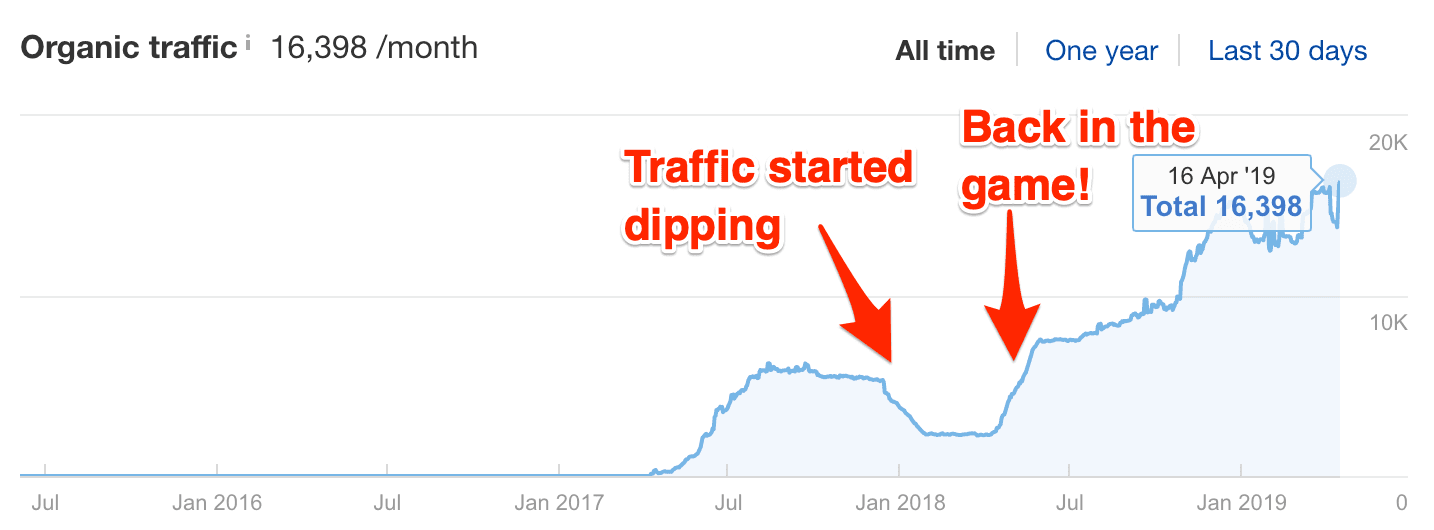 Content creation doesn’t end when you publish the first time. It is a continuous cycle of publishing, monitoring the results and then reworking the content over and over again until you rank well consistently.
I’d also recommend you do a content audit once a year. A content audit is an online version of a spring clean. What you do is to analyze the performance of all your content and then determine if you should update, delete, consolidate, redirect or maintain them.
Here’s a quick overview of how a content audit works:
Content creation doesn’t end when you publish the first time. It is a continuous cycle of publishing, monitoring the results and then reworking the content over and over again until you rank well consistently.
I’d also recommend you do a content audit once a year. A content audit is an online version of a spring clean. What you do is to analyze the performance of all your content and then determine if you should update, delete, consolidate, redirect or maintain them.
Here’s a quick overview of how a content audit works:
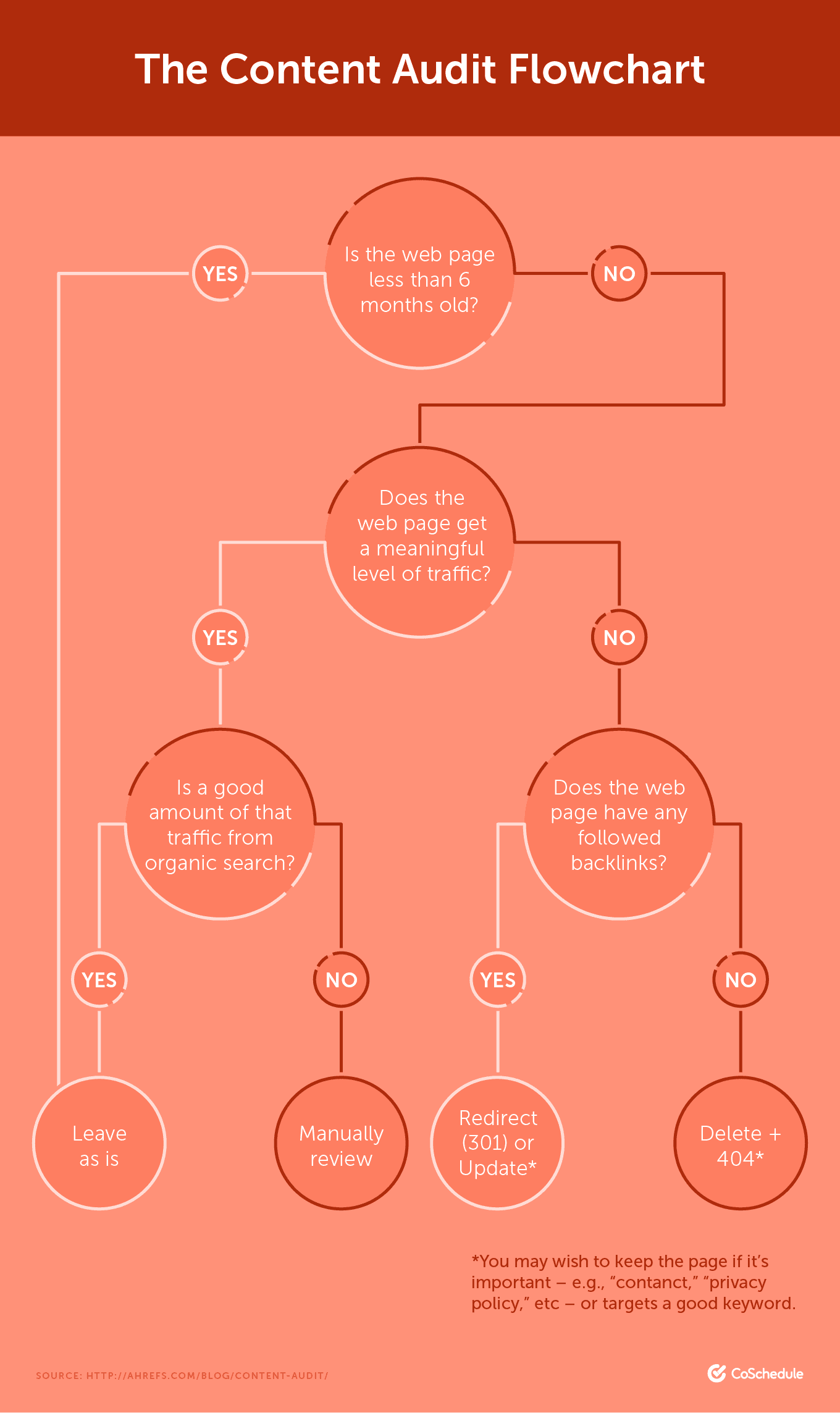 For a large site with thousands of pages, a content audit can be a challenging task. In this case, this blog post by Ryan Stewart is a great guide on how to do an enterprise-level content audit.
For a large site with thousands of pages, a content audit can be a challenging task. In this case, this blog post by Ryan Stewart is a great guide on how to do an enterprise-level content audit.
Stay on Top of Your Site Speed
In 2010, Google announced that page speed is a ranking factor. To check your page speed, you can use free tools like Google’s PageSpeed Insights.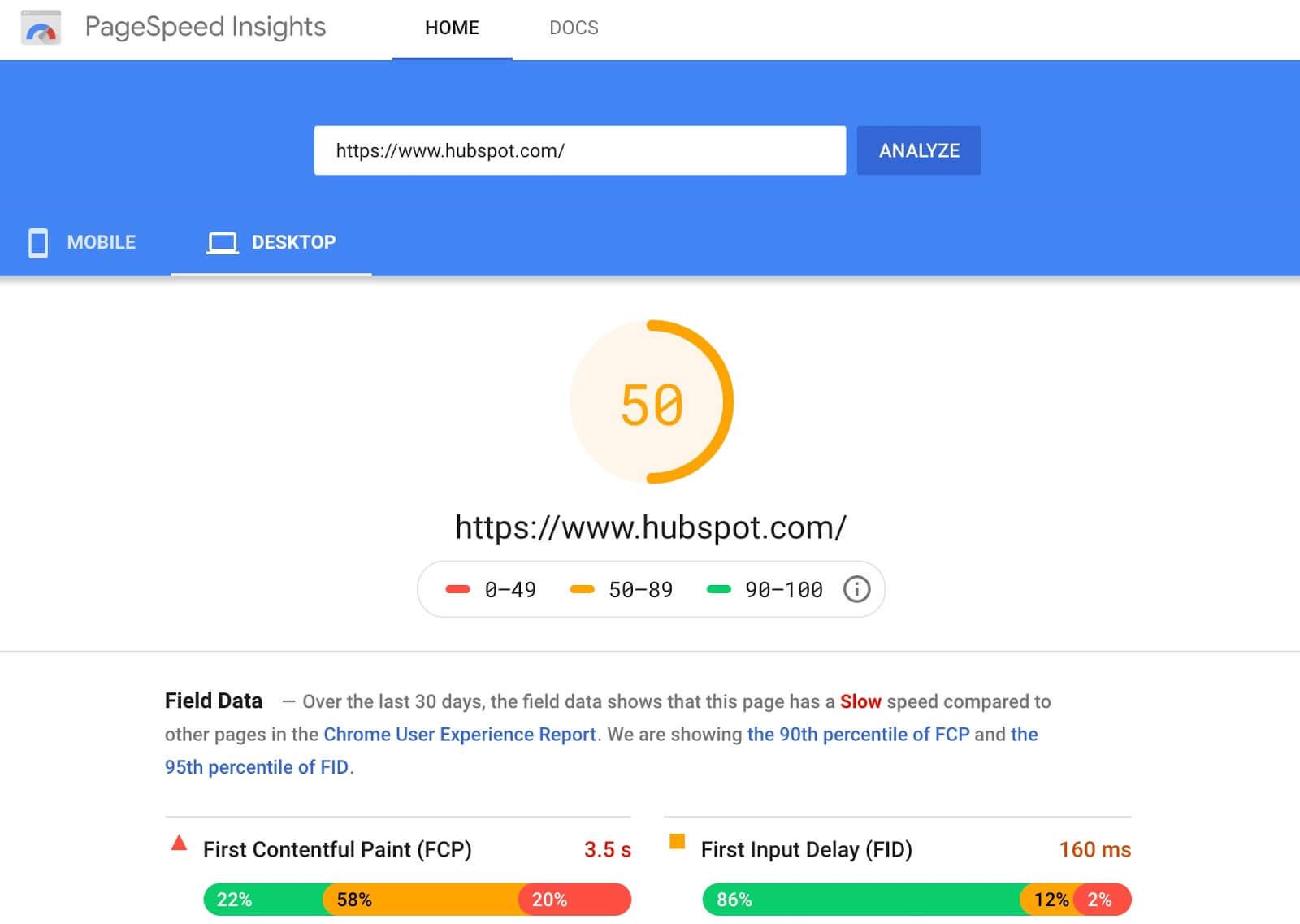 Not only will PageSpeed Insights tell you why it’s slow, it’ll also give you tips on how to improve your site speed.
Not only will PageSpeed Insights tell you why it’s slow, it’ll also give you tips on how to improve your site speed.
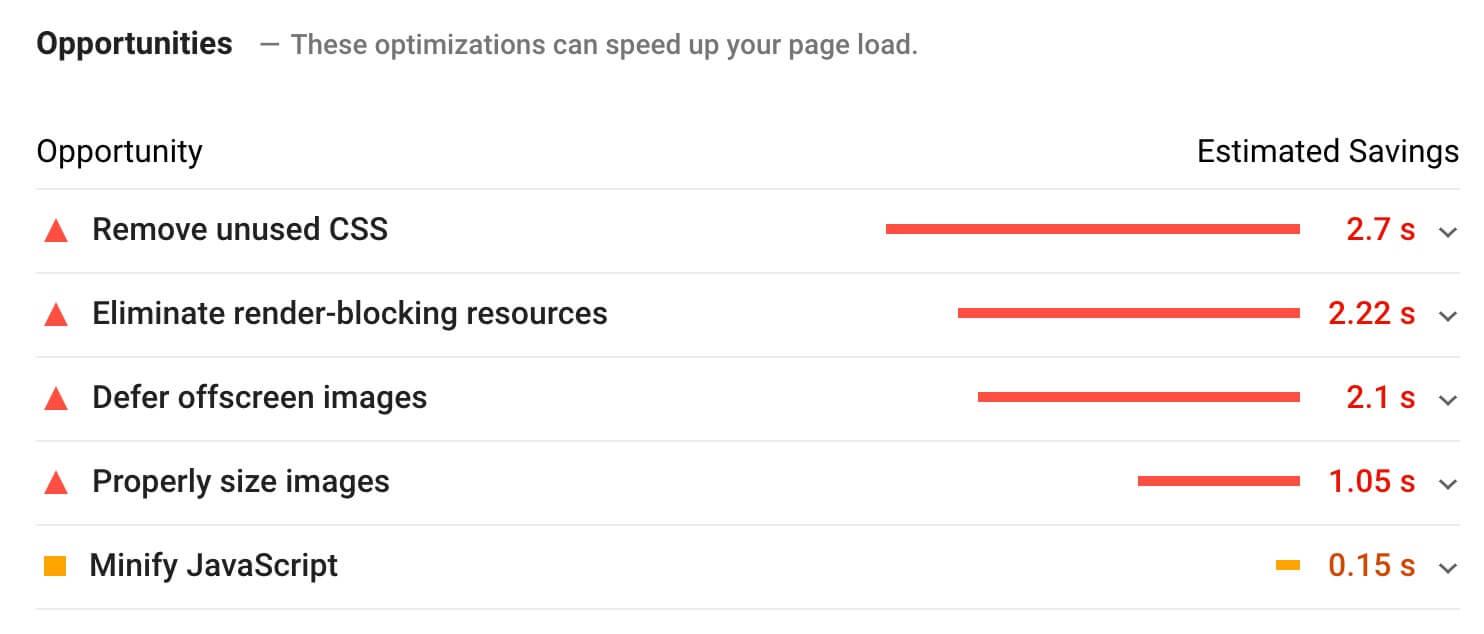 Here are a few ways you can improve your site speed:
Here are a few ways you can improve your site speed:
- Minify and combine files. If you’re using Wordpress, you can install a plugin like WPRocket to do this easily. Otherwise, get a developer to help.
- Enable browser caching. Browser caching allows your visitors to store elements of your page onto their hard drive. This allows them to load your page without sending another HTTP request to your server (faster loading!) Once again, a WordPress plugin like W3 Total Cache makes it easy to do. If not, get a developer.
- Reduce image sizes. Images can be large and hinder site speed. Use tools like WPSmush (for WordPress) or Compressor.io (non-WordPress) to reduce the image sizes on your website.
- Use a Content Delivery Network (CDN). A CDN helps to cache your site on a global network of servers. As such, when a user requests files from your site, this request is sent to the closest server. The user sees the same content, but it loads faster since it’s requesting files from a nearer server. For CDN options, you can take a look at Cloudflare.
- Use lazy loading. Lazy loading loads the content within view first, then load the bottom of the page later. This way, the user doesn’t have to wait to access the page, while the rest of the page will load as the user scrolls. With WordPress, this is easy, as you can simply install WPRocket.
How to Convince Stakeholder of Enterprise SEO Value
You know SEO works. You know your company needs SEO. But the problem is: your managers don’t believe you. And you need their approval to get started on an SEO program. Fret not. I’ll arm you with a few arguments that you can bring to your stakeholders so you can convince them of the value of SEO.Organic Traffic Has Staying Power
Paid marketing is like a faucet. Turn on the tap, and the traffic flows. However, there’s an issue. And that is: as soon as you stop the campaign or run out of budget, your traffic will dry up. And you will have no choice but to keep paying so you can maintain the flow of traffic. Social media isn’t much help either. For it to work, you need to either build a large audience or hope for viral hits. Both are difficult. And worse, social networks are now a pay-to-play game. If you’re not willing to pay, you’ll see your engagement drop. On the other hand, SEO doesn’t stop. It is an acquisition channel that will grow passively. As long as you are ranking well for the keywords you’re targeting, you will get traffic. Just take a look at how HubSpot’s search traffic has grown over the years: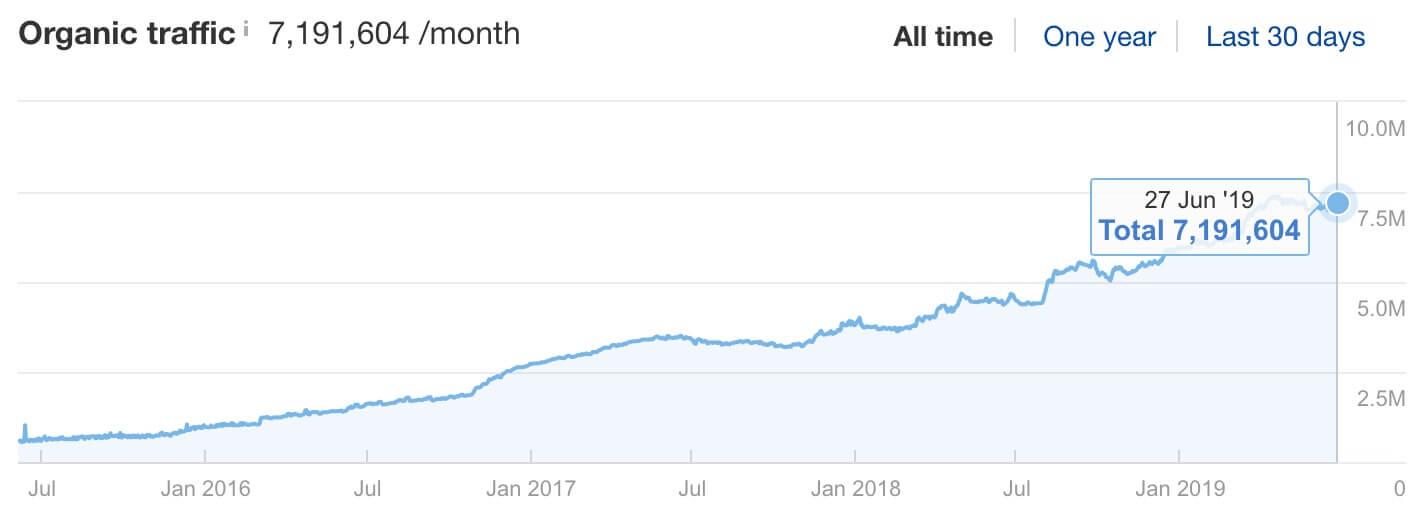 The entire marketing team could take a month’s break, and traffic will still continue to grow.
That’s how powerful SEO is.
The entire marketing team could take a month’s break, and traffic will still continue to grow.
That’s how powerful SEO is.
Your Competitors Are Doing It
Check out the Referring Domains profile of Moosend, an email marketing company: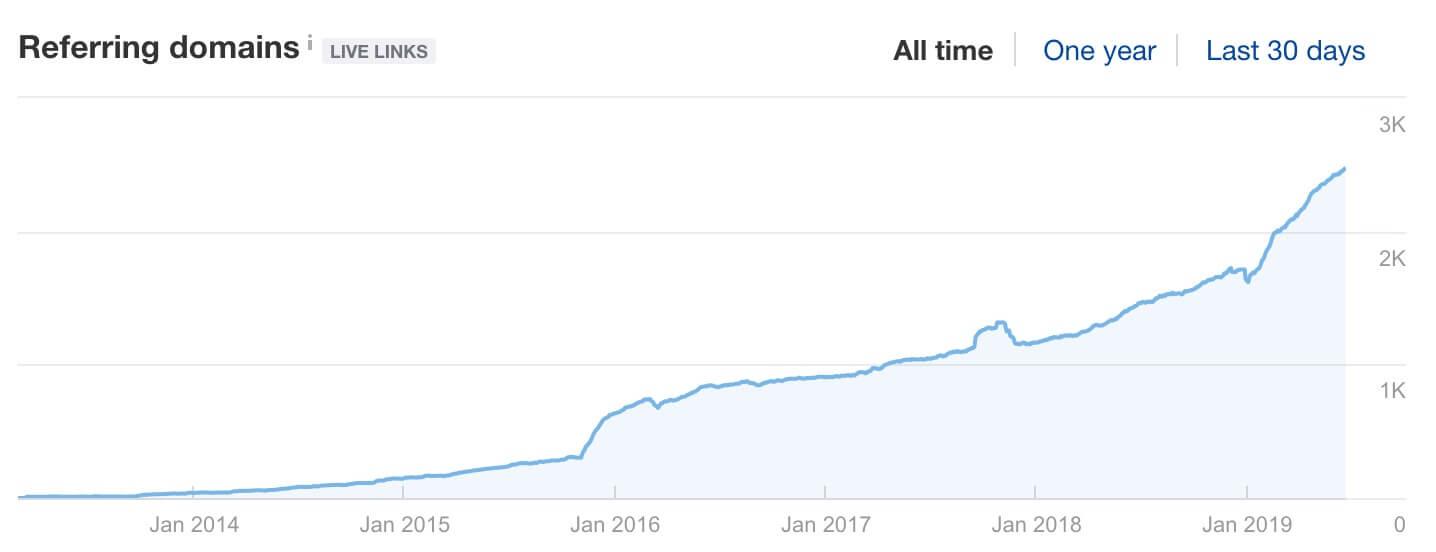 Despite being in an industry with countless competitors, Moosend has managed to slowly and steadily build up their link profile.
This is not an accident.
Nick Dimitriou, growth marketer at Moosend told me that SEO is a top priority, and they spend a lot of their time doing SEO-related activities like link building.
Moosend is not alone.
Sparktoro has found that the majority of businesses are spending more than $5,000 a month on SEO. In fact, the SEO industry is $80 billion and growing.
This means: it is likely that your competitors understand the importance of SEO, and are investing heavily in it.
Even if you’re in the top spot today, it’s only a matter of time your competitors start competing and challenging you for the #1 ranking.
Despite being in an industry with countless competitors, Moosend has managed to slowly and steadily build up their link profile.
This is not an accident.
Nick Dimitriou, growth marketer at Moosend told me that SEO is a top priority, and they spend a lot of their time doing SEO-related activities like link building.
Moosend is not alone.
Sparktoro has found that the majority of businesses are spending more than $5,000 a month on SEO. In fact, the SEO industry is $80 billion and growing.
This means: it is likely that your competitors understand the importance of SEO, and are investing heavily in it.
Even if you’re in the top spot today, it’s only a matter of time your competitors start competing and challenging you for the #1 ranking.
SEO Is Cheaper In The Long-Term
The Shopify blog gets an estimated ~375,000 search visitors per month. According to Ahrefs, the value of this traffic is a whopping ~$958,000/month or $11.5 million/year. NOTE. Traffic value is the value of a site or page’s search traffic if they had acquired that traffic via PPC (and not SEO.)
Given that there are only a few people on the Shopify team writing and editing content, and they aren’t paid a few million dollars each in salaries, this shows that SEO is a cheaper strategy over the long-term.
Get a few good writers and content marketers, and you can create a compounding machine that saves you money over time.
Contrast that with paid marketing. As Andrew Chen, General Partner at Andreessen Horowitz puts it:
“The longer your campaigns run, the less effective they become – people start seeing your ads too often. The messaging becomes stale, and novelty effects are real.”
NOTE. Traffic value is the value of a site or page’s search traffic if they had acquired that traffic via PPC (and not SEO.)
Given that there are only a few people on the Shopify team writing and editing content, and they aren’t paid a few million dollars each in salaries, this shows that SEO is a cheaper strategy over the long-term.
Get a few good writers and content marketers, and you can create a compounding machine that saves you money over time.
Contrast that with paid marketing. As Andrew Chen, General Partner at Andreessen Horowitz puts it:
“The longer your campaigns run, the less effective they become – people start seeing your ads too often. The messaging becomes stale, and novelty effects are real.”
SEO Gets Higher Quality Traffic
The beauty of SEO is that it matches perfectly to the buyer’s journey. The buyer’s journey is the research process a person goes through before making a purchase. Typically, there are four stages:- Awareness: The prospect realizes they have a problem.
- Interest: The prospect wants to understand more about their problem.
- Consideration: The prospect is comparing different solutions on the market.
- Conversion: The prospect is looking to purchase a solution.
Enterprise SEO Results and Case Studies
Still need more ammo to convince your company that SEO is worth the time and effort? Here are a few case studies and examples to help you make your case.NerdWallet
NerdWallet is an online personal finance website. Founded in 2009, NerdWallet has grown from 283 users in 2009 to 2.2 million users in 2014, and more today. How? You guessed it - SEO. In his talk for HustleCon, Tim Chen, the founder of NerdWallet shared how SEO was a huge driver for the growth of his site. In fact, search is driving >80% of their total traffic.
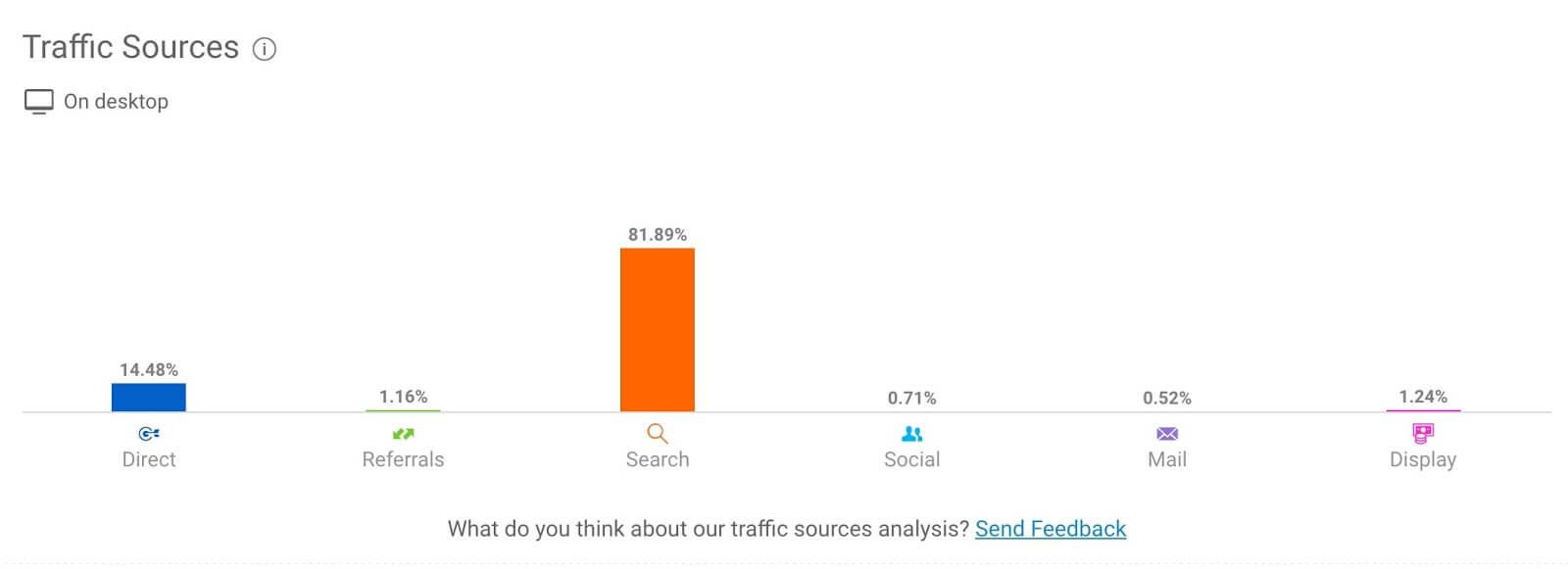 According to Ahrefs, NerdWallet is receiving an estimated ~12.6 million search visitors a month.
According to Ahrefs, NerdWallet is receiving an estimated ~12.6 million search visitors a month.
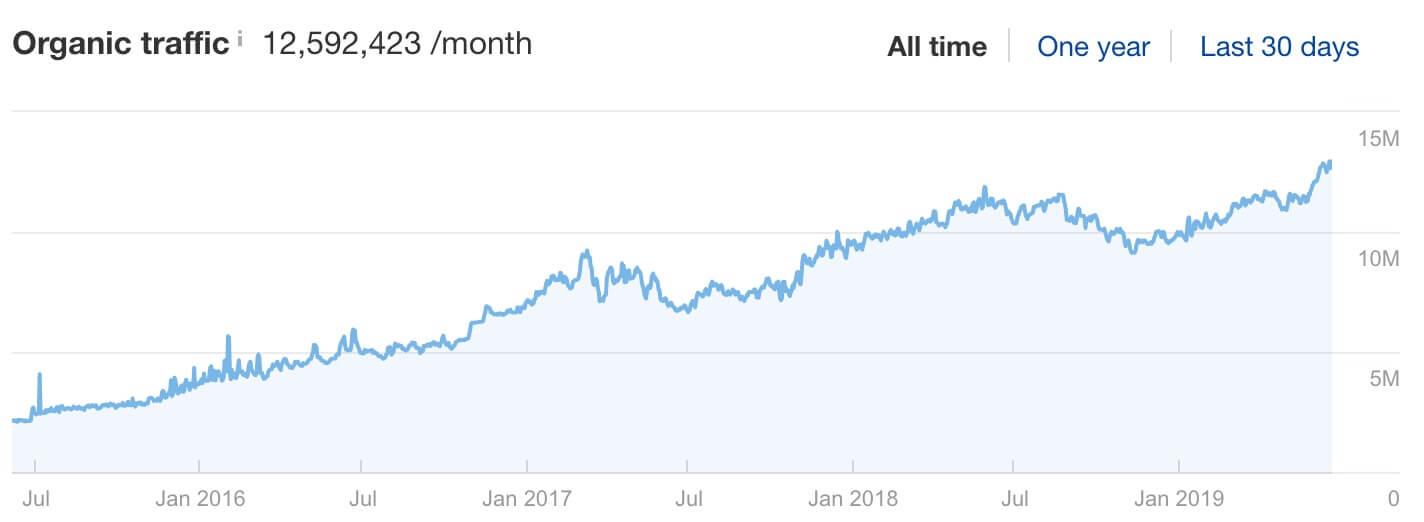 The result? In just a mere seven years, NerdWallet has grown to be worth $500 million.
The result? In just a mere seven years, NerdWallet has grown to be worth $500 million.
BuildFire
Started in 2014, BuildFire is a mobile app building platform that allows non-technical people to build their own apps. Right from the get-go, they focused on SEO. With the help of SEO expert Matthew Barby, BuildFire hit over 1,000,000 pageviews in a period of 12 months. They’ve maintained those results today. >80% of their traffic comes from search, and Ahrefs estimates that they are receiving 113,000 search visits per month.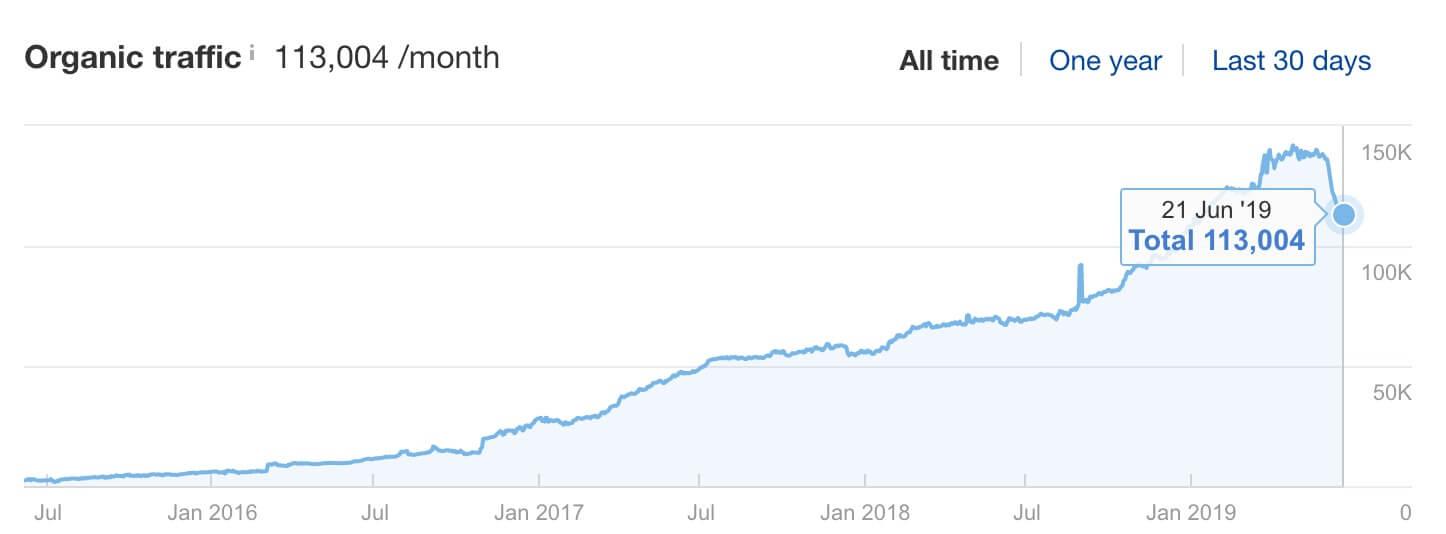 What does that mean for their business?
In a 2017 interview with Nathan Latka, founder Ian Blair reveals that they’re making $250,000+/month in monthly recurring revenue (MRR).
What does that mean for their business?
In a 2017 interview with Nathan Latka, founder Ian Blair reveals that they’re making $250,000+/month in monthly recurring revenue (MRR).
Venngage
Venngage is a free infographic maker that makes it easy for non-designers to create their own professional infographics. Most of their leads come from SEO. When Nadya first started, Venngage was only getting an estimated ~15,000 search visits per month. Today, Venngage is getting an incredible 1.2 million search visits a month (and growing!)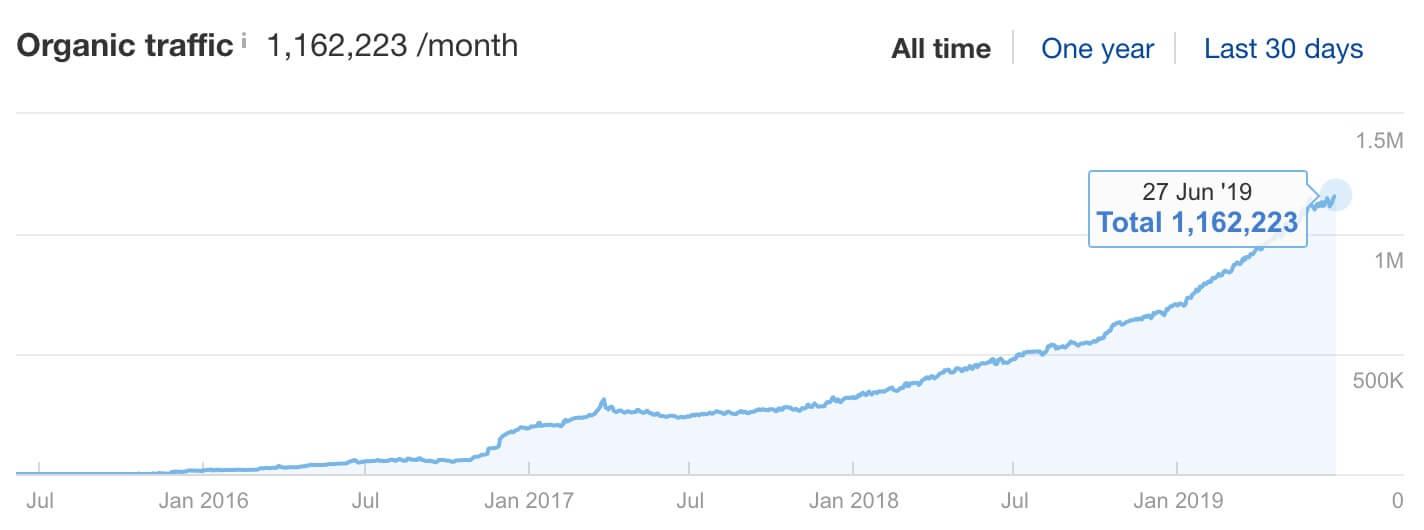 This has helped Venngage grow from 300 registrations per week in 2015 to 45,000 registrations per week today.
Their last recorded ARR was about ~$3 million in 2017, but they’ve definitely grown way past that with results like this.
This has helped Venngage grow from 300 registrations per week in 2015 to 45,000 registrations per week today.
Their last recorded ARR was about ~$3 million in 2017, but they’ve definitely grown way past that with results like this.


